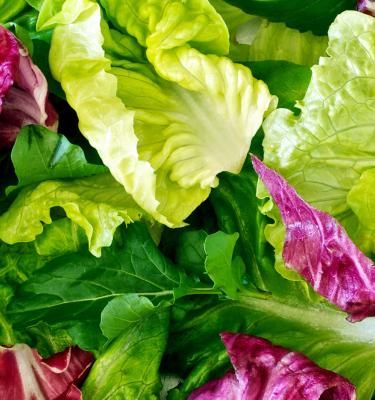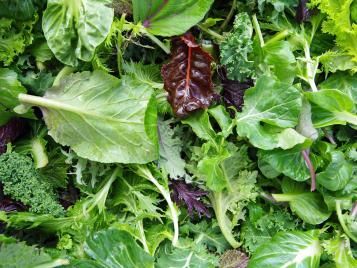

How to grow salad leaves
Bags of salad leaves are quite expensive to buy and have a fairly short lifespan in the fridge. Grow your own and you can pick exactly how much you want and need. By growing a range of different types and sowing at different times of year, you can have fresh salad leaves available nearly all year round. Many salads leaves are grown as ‘cut-and-come-again’ crops, which you can harvest over a long time.
Salad leaf varieties
There are lots of different salad leaves available. Here are some of the best and most popular ones. Many seed suppliers sell them as salad leaf mixes, with different types, colours and flavours.
- Chinese cabbage: Often sold as Chinese leaves, it is fast growing and can be ready for cutting in as little as 6 weeks.
- Corn salad or lamb’s lettuce: Hardy, making it the perfect choice for winter and early spring salads. It forms small rosettes of bright green, succulent leaves.
- Endive: Usually blanched to reduce its bitter content.
- Land cress or American cress: A tasty watercress substitute, ready to eat in 7 to 8 weeks.
- Rocket: An easy to grow, fast-maturing salad. Late summer sowings will continue cropping into the winter if the plants are protected by cloches.
- Winter purslane: An attractive winter salad also known as claytonia or miner’s lettuce.
- Oriental vegetables: There are numerous ways of using these, from adding to salads, stews and soup, for stir-fries and as a lightly steamed vegetable. They include Chinese mustard greens, chopsuey greens, Japanese mustard spinach (komatsuna), mibuna and mizuna and texel greens.

What you’ll need to start growing salad leaves
Get your salad leaves off to a good start with these growing essentials:
- Garden fork and spade
- Trowel
- Well-rotted farmyard manure
- General purpose fertilizer
- Salad leaf seeds
For container sowing:
- A suitable container, such as a windowbox or pot
- Multipurpose compost
- Balanced liquid plant food
How to grow salad leaves
Cultivation
Most salad leaves prefer an open, sunny position, although they will tolerate light shade. During hot, sunny summers, they may do better in light shade.
Before sowing, improve the soil with some organic matter to improve water holding and add a dressing of a general granular plant food.
Most salad leaves can also be grown in small pots, window boxes, growing bags or planters. Grow some in containers on the windowsill to have them ready at your finger tips - and at times when it may be too cold outside.
Sowing salad leaves
Sow in short rows every fortnight or so, enough for your needs, to have a continuous crop. Sow seeds thinly 13mm (0.5in) deep, cover with soil and water in well.
How to care for salad leaves
Keep the soil moist at all times, but without overwatering. If the soil dries out the plants may bolt (go to seed prematurely) and lose their strong flavours.
If necessary, thin out seedlings when they’re about 2.5cm (1in) high. The thinnings can be used in the kitchen.
To encourage fast growth that is tender and full of flavour, feed plants every 3 weeks with a balanced liquid feed.
Harvesting salad leaves
Harvest leaves as and when needed once the plants are about 7.5-10cm (3-4in) high. You can either pick individual leaves from the outside of the plants or harvest over the whole plant using scissors.
It is best to cut in the morning, when the plants will be at their freshest.
Common salad pests and diseases
Grey mould/botrytis mould
Grey mould is a fungal disease that appears as pale discoloured patches on salad leaves, turning to a grey fuzzy growth. It is more common in wet weather.
- Remove any affected plants promptly.
- Space plants well when planting to allow good air circulation.
- There are no chemical controls available for grey mould.
Slugs and snails
Slugs and snails feed on young lettuce seedlings, and can be identified by the slime trails that they leave, as well as the damage they do.
- Check plants at night and remove slugs and snails by hand.
- Covering the soil around plants with crushed eggshells or grit may have some effect.
- Scatter environmentally-friendly slug pellets if other methods are insufficient.
Lettuce root aphid
Lettuce root aphids feed on the roots of lettuce plants, causing plants to suddenly wilt and die. It is more common in dry conditions.
- Water regularly especially during dry periods.
- Grow lettuce under insect-proof mesh.
- Pull up and destroy affected plants.
Key features of salad leaves
| Foliage season(s) | Spring, Summer, Autumn, Winter |
|---|---|
| Sunlight | Partial shade, Full sun |
| Soil type | Clay, Loamy, Sandy |
| Soil pH | Neutral |
| Soil moisture | Moist but well-drained |
| Ultimate height | Up to 30cm (12in) |
| Ultimate spread | Up to 15cm (6in) |
| Time to ultimate height | 4-10 weeks |




